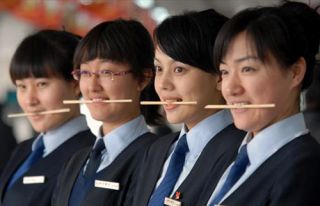Stress
Smiling and Stress
Smiling speeds recovery when a stressful experience is over.
Posted September 13, 2012
Sometimes your joy is the source of your smile, but sometimes your smile can be the source of your joy. — Thich Nhat Hanh
An interesting research report, by Tara Kraft and Sarah Pressman, will soon be published in Psychological Science. Their research speaks directly to well-being, psychological and physical, and the link between these two spheres. The researchers wondered about the effects of smiling on physiological recovery from stress.
The innovation of their research was that they deliberately manipulated whether participants were smiling or not — making this a true experiment — and further took steps to avoid “demanding” hypothesized responses from these participants*.
Kraft and Pressman (2012) studied 169 college students, telling them that their investigation concerned multi-tasking. Participants were hooked up to a monitor that assessed their heart rate in beats per minute throughout the entire experiment. Heart rate is a simple and reliable way to measure experienced stress — the higher the rate, the more stress someone is experiencing.
After a 10-minute acclimation period, participants were asked to spend two minutes doing a difficult task, using their non-dominant hand to trace a star-shaped design without going off a provided outline. Oh, and they could only see what they were doing while viewing a mirror image of their hand, which is to say a reversed image. Accuracy was emphasized, and participants were given false information about “average” performance: eight tracings in two minutes with fewer than 25 errors. In reality, participants could only manage two tracings and on average made more than 25 errors.
A five-minute recovery period ensued, followed by another stress-inducing task, submerging one’s hand in ice water for one minute, a painful but not harmful experience. Then there was another five-minute recovery period.

Are you following? Here comes the gist of the experiment. During the stress tasks (not the recovery periods), participants were assigned to different conditions. Those in the neutral expression control group were asked to hold the ends of chopsticks gently in their mouth while relaxing their face. Those in the standard smiling group did the same while using their zygomaticus major muscles**, those involved in raising the corners of the mouth, thereby producing a facial smile. Those in the Duchenne smiling group held chopsticks cross-wise in their mouths while using their zygomaticus major muscles as well as their orbicularis oculi muscles, those involved in closing the eyelids, thereby producing the full-faced smile known as a Duchenne smile. Duchenne smiles are often characterized as genuine ones, and they predict marital satisfaction as well as longevity, presumably because their frequent display is a marker of a happy and satisfied life (Abel & Kruger, 2010; Harker & Keltner, 2001). Participants were provided coaching and shown photo examples of how they should look in each condition. Their fidelity to the instructions was later checked by raters watching videotapes.
Half of the participants in each of the two smiling groups were explicitly told to smile, which is how the researchers controlled for demand characteristics. These participants were aware that they should be smiling, whereas other participants were simply told how to hold their faces.
The experiment had five conditions: (1) neutral expression; (2) standard smiling without awareness; (3) standard smiling with awareness; (4) Duchenne smiling without awareness; and (5) Duchenne smiling with awareness. Their heart rate was monitored throughout, and the crucial analyses looked at reductions in heart rate following the multiple tasks as a function of condition.
Results were straightforward and as expected. Regardless of their awareness, smiling participants recovered more quickly from stress than those with neutral expressions, and those displaying Duchenne smiles recovered somewhat more quickly than those displaying a standard smile.
So, smiling speeds recovery from stress. How? The research did not directly test possible biological mechanisms, but perhaps smiling influences blood flow in the brain, thereby undoing the effects of stress. In any event, let me draw out some of the implications.
Smile while you are stressed, genuinely if possible. But faking — i.e., smiling with just your mouth — may still be worth your effort. Doing so does not reduce stress in the moment, but it speeds recovery when a stressful experience is over. That said, Kraft and Pressman cautioned that their finding applies to recovery from short-term stress. The long-term display of emotions one is not really feeling may actually take a toll (Goldberg & Grandey, 2007).
I just talked to a writer for a fitness magazine, who had heard about this study and was writing a story on it. He asked if smiling during a workout made it easier. My opinion was “Not exactly.” For starters, exercise raises one’s heartbeat, but I assume in a different way than the stressful tasks in Kraft and Pressman’s experiment. Much as I would like to believe that stress caused by multi-tasking constitutes aerobic exercise, I suspect it does not. And in any event, the research was about recovery from stress and not about the reduction of stress per se.
Still, smiling during exercise may make a workout more enjoyable, if only because it makes the smiling person more approachable by others. I have a strong opinion that workouts would be more enjoyable for most of us if these workouts were more social and not pursued in grim indifference to those sharing the same gym (Peterson & Xydis, 2011). Smiling opens doors, at gyms and elsewhere.
Late at night, when I am flipping through television shows, I sometimes come across an infomercial pushing some sort of exercise device or program. The people depicted are of course fit and attractive, but they also have a strange expression on their face, which I finally have identified. It is not exactly a smile. It is a display of smugness, as in “I am ripped and you are not,” which I find off-putting. I would be more inclined to purchase whatever is being urged on me if these folks were simply smiling.
I find it intriguing that Duchenne smiles can be deliberately created, which goes against their common interpretation as genuine and thus impossible to fake. However, I remember some years ago teaching a small seminar class in which I mentioned Duchenne smiles. I commented that they could not be faked. A student raised her hand. I acknowledged her, and she gave the whole class a wonderful Duchenne smile. I just stared back at her, speechless for a moment. Then I asked, “How did you do that? Are you faking?”
She smiled, again, radiantly, and said, “What makes you think I’m faking? I’m just smiling. I’m a theater major, by the way, and I have learned how to express emotions.”
What ensued was a fascinating discussion of method acting, and I think positive psychology, in its search for interventions that bolster well-being, could learn much from the strategies of Stanislavski, Strasberg, and others.
Cheers.
* What are called demand characteristics can plague studies of sentient human beings, who may try to figure out what is expected of them in an investigation and then act accordingly, confirming the research hypothesis for irrelevant reasons (Orne, 1962). Imagine a psychology laboratory to which potential participants report for a study. As participants wait in the hallway for the study to begin, they see a bulletin board on which are posted descriptions of past studies conducted by those who run the laboratory. Is it far-fetched to suppose that some potential participants read these descriptions, think about them, and once the study begins recognize the research paradigm as one intended to investigate the effects of X on Y? Is it far-fetched to think that the behavior of these participants is thereby influenced?
** According to Wikipedia, variations in the structure of these muscles produce dimples. Mario Lopez should be grateful for his zygomaticus major muscles, which have made him a celebrity.
References
Abel, E. L., & Kruger, M. L. (2010). Smile intensity in photographs predicts longevity. Psychological Science, 21 , 542–544.
Goldberg, L. S., & Grandey, A. A. (2007). Display rules versus display autonomy: Emotion regulation, emotional exhaustion, and task performance in a call center simulation. Journal of Occupational Health Psychology, 12, 301-318.
Harker, L. A., & Keltner, D. (2001). Expressions of positive emotion in women’s college yearbook pictures and their relationship to personality and life outcomes across adulthood. Journal of Personality and Social Psychology, 80 , 112–124.
Kraft, Tara L., & Pressman, Sarah D. (2012). Grin and bear it: The influence of manipulated facial expression on the stress response. Psychological Science.
Orne, Martin T. (1962). On the social psychology of the psychological experiment: With particular reference to demand characteristics and their implications. American Psychologist, 17, 776–783.
Peterson, C., & Xydis, K. (2011). Positive psychology for health and fitness professionals. Tucson, AZ: DSWFitness.




